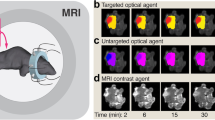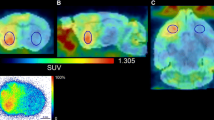Abstract
Purpose
To investigate the potential of targeted MR signal amplification strategy for imaging of EGF receptor variant III (EGFRvIII) overexpression associated with the infiltrating margin of aggressive orthotopic brain tumors.
Procedures
F(ab′)2 fragments of humanized anti-EGFRvIII monoclonal antibody (EMD72000) were linked to deglycosylated horseradish peroxidase (HRP) and glucose oxidase (GOX). Detection of the F(ab′)2 conjugate pair colocalization in vivo was enabled by a subsequent IV injection of a low molecular weight paramagnetic substrate of HRP, diTyr-GdDTPA.
Results
The delivery of the targeted fragments to the tumor was validated using SPECT/CT imaging of radiolabeled anti-EGFRvIII F(ab′)2 conjugates. Further, by using 3 T MRI, we observed time-dependent differences in tumor signal intensity and signal retention at the endpoint depending on whether or not the animals were pre-injected with the anti-EGFRvIII F(ab′)2 conjugates.
Conclusions
Imaging of EGFRvIII expression in vivo was enabled by consecutive administration of targeted F(ab′)2 conjugates and a paramagnetic substrate resulting in a tumor-specific receptor detection with high specificity and resolution.






Similar content being viewed by others
References
Weller M, Stupp R, Hegi M, Wick W (2012) Individualized targeted therapy for glioblastoma: Fact or fiction? Cancer J 18:40–44
Zalatimo O, Zoccoli CM, Patel A et al (2013) Impact of genetic targets on primary brain tumor therapy: What's ready for prime time? Adv Exp Med Biol 779:267–289
Murat A, Migliavacca E, Gorlia T et al (2008) Stem cell-related "Self-renewal" Signature and high epidermal growth factor receptor expression associated with resistance to concomitant chemoradiotherapy in glioblastoma. J Clin Oncol 26:3015–3024
Chung I, Akita R, Vandlen R et al (2010) Spatial control of egf receptor activation by reversible dimerization on living cells. Nature 464:783–787
Ekstrand AJ, Longo N, Hamid ML et al (1994) Functional characterization of an egf receptor with a truncated extracellular domain expressed in glioblastomas with egfr gene amplification. Oncogene 9:2313–2320
Nishikawa R, Ji XD, Harmon RC et al (1994) A mutant epidermal growth factor receptor common in human glioma confers enhanced tumorigenicity. Proc Natl Acad Sci U S A 91:7727–7731
Shinojima N, Tada K, Shiraishi S et al (2003) Prognostic value of epidermal growth factor receptor in patients with glioblastoma multiforme. Cancer Res 63:6962–6970
Hu J, Jo M, Cavenee WK et al (2011) Crosstalk between the urokinase-type plasminogen activator receptor and EGF receptor variant III supports survival and growth of glioblastoma cells. Proc Natl Acad Sci U S A 108:15984–15989
Reist CJ, Batra SK, Pegram CN et al (1997) In vitro and in vivo behavior of radiolabeled chimeric anti-EGFRVIII monoclonal antibody: comparison with its murine parent. Nucl Med Biol 24:639–647
Mishima K, Johns TG, Luwor RB et al (2001) Growth suppression of intracranial xenografted glioblastomas overexpressing mutant epidermal growth factor receptors by systemic administration of monoclonal antibody (mAb) 806, a novel monoclonal antibody directed to the receptor. Cancer Res 61:5349–5354
Johns TG, Adams TE, Cochran JR et al (2004) Identification of the epitope for the epidermal growth factor receptor-specific monoclonal antibody 806 reveals that it preferentially recognizes an untethered form of the receptor. J Biol Chem 279:30375–30384
Takasu S, Takahashi T, Okamoto S et al (2003) Radioimmunoscintigraphy of intracranial glioma xenograft with a technetium-99m-labeled mouse monoclonal antibody specifically recognizing type III mutant epidermal growth factor receptor. J Neurooncol 63:247–256
Ciardiello F (2005) Epidermal growth factor receptor inhibitors in cancer treatment. Future Oncol 1:221–234
Wagner TD, Yang GY (2008) Cetuximab: its use in combination with radiation therapy and chemo-therapy in the multimodality treatment of head and neck cancer. Recent Pat Anticancer Drug Discov 3:76–83
Weber J, McCormack PL (2008) Panitumumab: in metastatic colorectal cancer with wild-type kras. BioDrugs 22:403–411
Kamat V, Donaldson JM, Kari C et al (2008) Enhanced egfr inhibition and distinct epitope recognition by egfr antagonistic mAbs c225 and 425. Cancer Biol Ther 7:726–733
Shazeeb MS, Sotak CH, DeLeo M 3rd, Bogdanov A Jr (2011) Targeted signal-amplifying enzymes enhance MRI of EGFR expression in an orthotopic model of human glioma. Cancer Res 71:2230–2239
Bogdanov A Jr, Matuszewski L, Bremer C et al (2002) Oligomerization of paramagnetic substrates results in signal amplification and can be used for mr imaging of molecualr targets. Mol Imaging 1:16–23
Querol M, Bennett DG, Sotak C et al (2007) A paramagnetic contrast agent for detecting tyrosinase activity. ChemBioChem 8:1637–1641
Bogdanov A Jr, Kang HW, Querol M et al (2007) Synthesis and testing of a binary catalytic system for imaging of signal amplification in vivo. Bioconjug Chem 18:1123–1130
Bogdanov AJ, Shazeeb MS, Gupta S (2012) Humanized anti-EGFR antibody fragment/dual enzyme system assists in mr imaging of the receptor deletion variant expression in vivo. The 2012 World Molecular Imaging Congress; 2012. Springer, Dublin, IR, p S1576
Hnatowich DJ, Qu T, Chang F et al (1998) Labeling peptides with technetium-99m using a bifunctional chelator of a n-hydroxysuccinimide ester of mercaptoacetyltriglycine. J Nucl Med 39:56–64
Rasband W. ImageJ. In: Health USNIo, editor. Bethesda, MD, USA, http://rsb.info.nih.gov/ij/; 1997.
van Dongen GA, Visser GW, Lub-de Hooge MN et al (2007) Immuno-PET: a navigator in monoclonal antibody development and applications. Oncologist 12:1379–1389
Sharkey RM, Rossi EA, McBride WJ et al (2010) Recombinant bispecific monoclonal antibodies prepared by the dock-and-lock strategy for pretargeted radioimmunotherapy. Semin Nucl Med 40:190–203
McCabe KE, Liu B, Marks JD et al (2012) An engineered cysteine-modified diabody for imaging activated leukocyte cell adhesion molecule (alcam)-positive tumors. Mol Imaging Biol 14:336–347
Stoldt HS, Aftab F, Chinol M et al (1997) Pretargeting strategies for radio-immunoguided tumour localisation and therapy. Eur J Cancer 33:186–192
Boerman OC, van Schaijk FG, Oyen WJ, Corstens FH (2003) Pretargeted radioimmunotherapy of cancer: progress step by step. J Nucl Med 44:400–411
Goldenberg DM, Chang CH, Rossi EA et al (2012) Pretargeted molecular imaging and radioimmunotherapy. Theranostics 2:523–540
Artemov D, Mori N, Ravi R, Bhujwalla ZM (2003) Magnetic resonance molecular imaging of the her-2/neu receptor. Cancer Res 63:2723–2727
Zeglis BM, Mohindra P, Weissmann GI et al (2011) Modular strategy for the construction of radiometalated antibodies for positron emission tomography based on inverse electron demand diels-alder click chemistry. Bioconjug Chem 22:2048–2059
Schmiedel J, Blaukat A, Li S, Knochel T, Ferguson KM (2008) Matuzumab binding to EGFR prevents the conformational rearrangement required for dimerization. Cancer Cell 13:365–373
Packard SD, Mandeville JB, Ichikawa T et al (2003) Functional response of tumor vasculature to Paco2: Determination of total and microvascular blood volume by MRI. Neoplasia 5:330–338
Acknowledgments
This work was supported by 5RO1AG034901-03 and 5R01EB000858 grants to AB. We are grateful to Jamie O’Callaghan and Dr. Shaokuan Zheng for assistance with several technical aspects of this work. We are grateful to Dr. Mary Mazzanti for editing the text.
Conflict of Interest
The authors declare that they have no conflicts of interest.
Author information
Authors and Affiliations
Corresponding author
Rights and permissions
About this article
Cite this article
Shazeeb, M.S., Gupta, S. & Bogdanov, A. MR Signal Amplification for Imaging of the Mutant EGF Receptor in Orthotopic Human Glioma Model. Mol Imaging Biol 15, 675–684 (2013). https://doi.org/10.1007/s11307-013-0653-8
Published:
Issue Date:
DOI: https://doi.org/10.1007/s11307-013-0653-8




